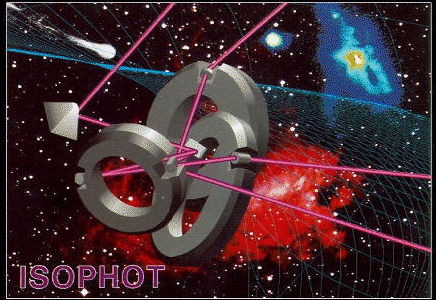

The principal investigator for ISO PHOTometer is D. Lemke (MPIA, Heidelberg, Germany). ISOPHOT comprises 3 sub-systems, a photometer which can do polarimetry at short wavelengths in addition to multi-aperture, multi-filter photometry (PHT-P), a long-wavelength, photometric camera (PHT-C), and two low-resolution, grating spectrophotometers (PHT-S). PHT-P covers the wavelength range 2.5um to 120um with 14 filters (resolving power ranges from 1.7 to 17.4). The 13 apertures vary in diameter from 5.0" to 180" (although 2 of them are rectangular not circular). Polarimetry is possible with PHT-P between 2.5um and 30um. PHT-C has 2 two-dimensional mosaic arrays of detectors, operating from 50um to 200um. There are 6 filters for the shorter wavelength camera array (which has nine 43.5" pixels), and there are 5 filters for the longer wavelength camera (which has four 89.4" pixels). Polarisation can be done with any filter in PHT-C. The two grating spectrophotometers in PHT-S operate from 2.5um to 5um and from 6um to 12um. Each spectrometer has an array of 64 detectors, and PHT-S has a resolving power of around 90.
PHOTOMETRY: There is a wide range of photometric observations possible, using PHT, including multi-filter, multi-aperture, absolute photometry (w.r.t. internal calibrators), and these may be made with single pointings, raster scans, linear scans, variability monitoring or sparse maps. Chopped observations can be made with background up to 330" away (depending upon the selected aperture). The aperture given here is the diffraction limited one. Only point source sensitivities are given here. The sensitivities are estimated using an intergration time (on source) of 100 sec, and S/N=10, assuming moderate background.
Filter Resolving Aper. Flux Comments
power limit
PHT-P
P_3.29 17.4 5.0 31mJy Feature
P_3.6 3.4 5.0 6.2 Common to SWS
P_4.85 3.2 7.6 4.2
P_7.3 2.3 13.8 2.6
P_7.7 9.8 13.8 12 Feature
P_10 5.6 18 7.9
P_11.3 15 18 29 Feature
P_11.5 1.8 23 2.5 IRAS-like
P_12.8 5.6 23 6.7
P_16 4 23 6.5
P_20 2.3 52 7.7
P_25 2.6 52 8.5 IRAS-like
P_60 1.7 99 35 IRAS-like
P_100 2.3 180 91 IRAS-like
PHT-C
C_50 1.3 45
C_60 1.7 43
C_70 1.8 35
C_90 1.7 20
C_100 2.3 33
C_105 2.8 57
C_120 2.3 31
C_135 2.2 28
C_160 2.0 25
C_180 3.1 56
C_200 5.7 258
Aperture list
Size (arcsec) Comments
5.0 circular
7.6 circular
10 circular
13.8 circular
18 circular
20 x 32 Common to SWS
23 circular
52 circular
79 circular
99 circular Common to LWS
120 circular
127 x 127
180 circular
POLARIMETRY:
The 3 polarisers + clear aperture can be viewed by both PHT-P (not with the
60um and 100um filters) and PHT-C. The sensitivities are calculated with an
exposure time of 100 sec for each polariser setting, and a required absolute
error in the degree of polarisation of 1%. A polariser illuminated with
unpolarised radiation transmits a fraction T of the incident intensity. P'
is the degree of polarisation of the transmitted radiation. Each polariser
is used twice in an observation, to improve reliability. Observations are
permitted through one filter, several filters, several apertures, with the
possibility of a raster scan or sparse map. Only point source sensitivities
are given here.
Filter Central Polariser Eff Flux
wavelength T P' limit
PHT-P
P_3.29 3.30 0.35 0.90 656mJy
P_3.6 3.63 0.35 0.90 160
P_4.85 4.85 0.35 0.91 108
P_7.3 7.4 0.35 0.91 64
P_7.7 7.65 0.35 0.91 307
P_10 9.90 0.35 0.92 194
P_11.3 11.4 0.35 0.92 720
P_11.5 11.8 0.35 0.92 51
P_12.8 12.8 0.35 0.93 160
P_16 15.6 0.35 0.94 152
P_20 20.7 0.35 0.96 147
P_25 23.9 0.35 0.97 170
PHT-C
C_50 66 0.52 0.89 757
C_60 64 0.51 0.92 717
C_70 80 0.50 0.95 579
C_90 93 0.50 0.96 311
C_100 100 0.50 0.97 534
C_105 105 0.50 0.97 925
C_120 115 0.51 0.98 468
C_135 146 0.51 0.99 419
C_160 160 0.52 0.99 362
C_180 173 0.52 0.99 850
C_200 188 0.52 0.99 3990